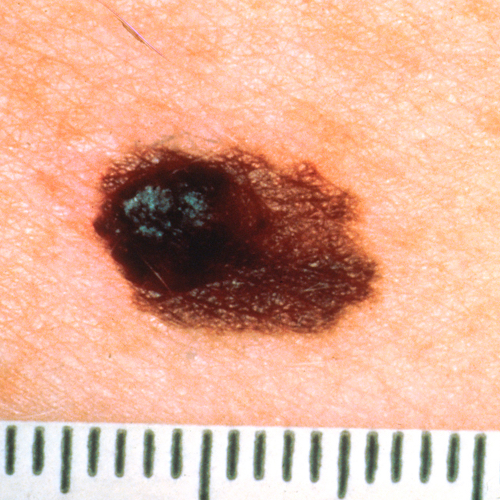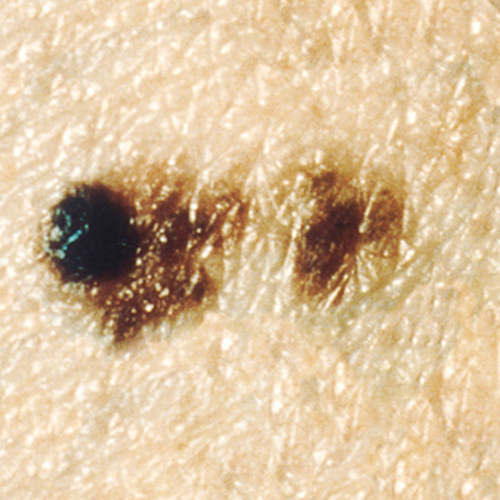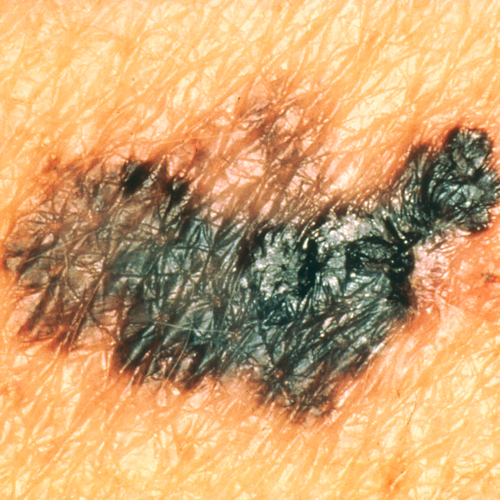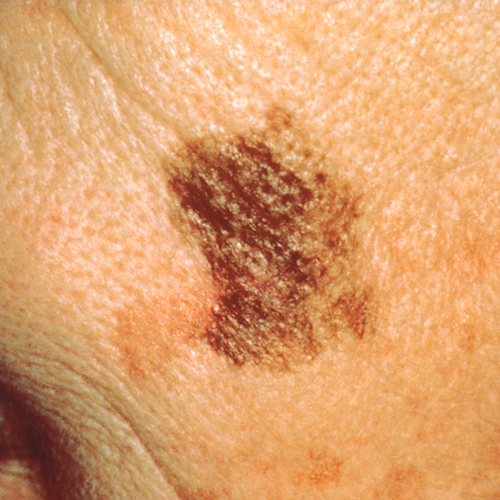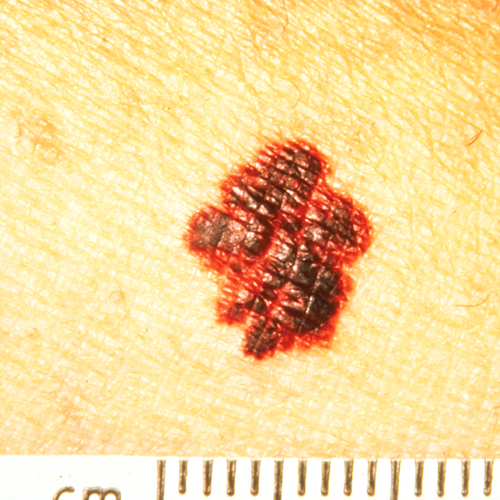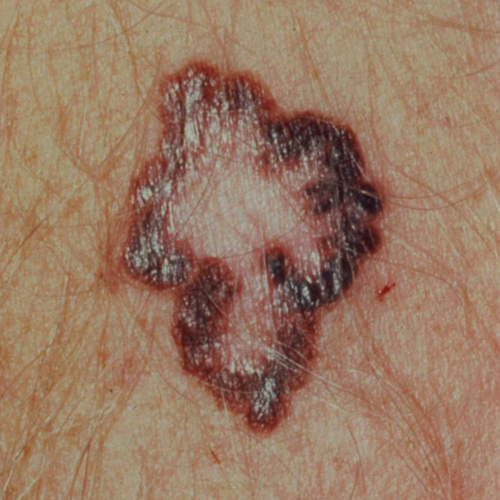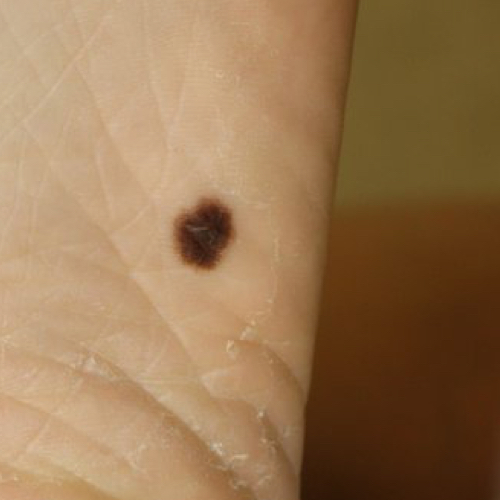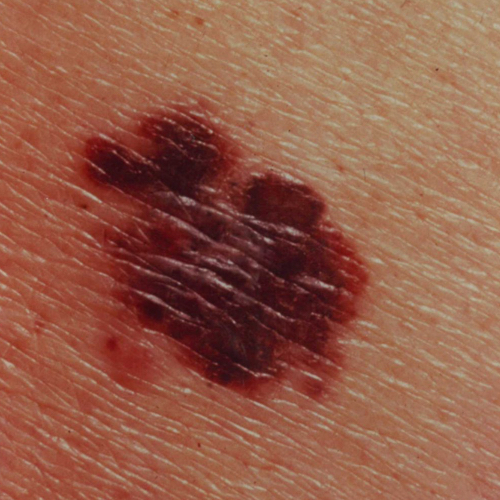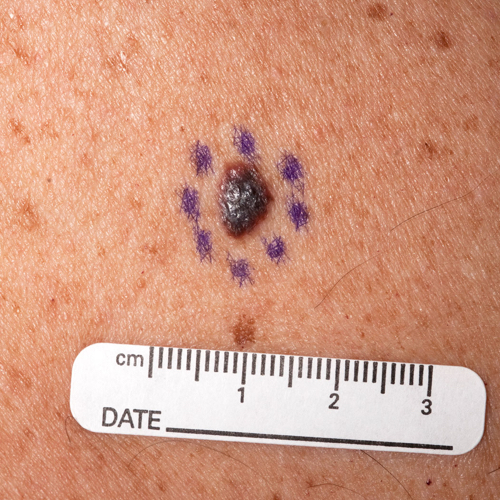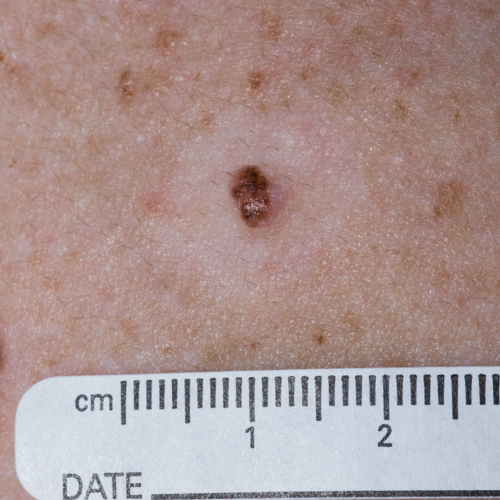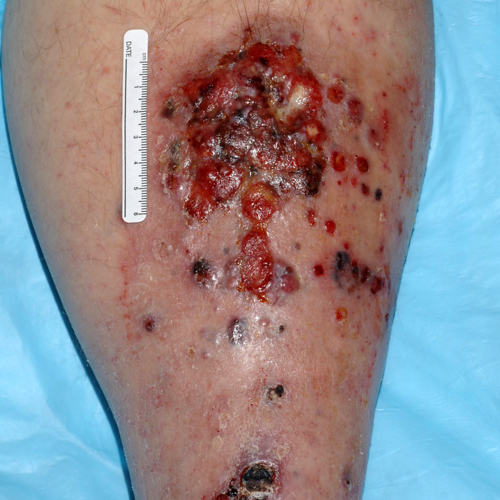The Main Types of Melanoma
Reviewed by: HU Medical Review Board | Last reviewed: May 2017. | Last updated: June 2019
Melanoma has many different appearances. Becoming familiar with the appearances of melanoma can help you and your doctor detect and treat this cancer in its early stages.1
Melanomas are classified based on their location, the amount of sun damage to surrounding skin, and patient age.1 The four main types of melanoma are:
- Superficial spreading melanoma
- Nodular melanoma
- Lentigo maligna melanoma
- Acral lentiginous melanoma
In the future, melanomas may be classified by their specific genetic mutations. About 70% of melanomas have a known mutation.2
Superficial spreading melanoma
Superficial spreading melanoma is the most common type of melanoma.3,4 It accounts for 70% of melanomas.3 These tumors are found on skin that has intermittent sun exposure, such as the back, chest, arms, and legs.1 Mutations in the BRAF gene are common.1
What are the signs of superficial spreading melanoma?
Superficial spreading melanoma has been described as a “brown-black stain that is spreading from a mole.”4 The tumor may be asymmetrical, have uneven borders, and color variation.3 It may slowly grow outward (spread) before it begins to invade deeper layers of skin.3 You may not feel any symptoms.
Who typically develops superficial spreading melanoma?
Fair-skinned people aged 30 to 50 years old are the most likely to be diagnosed with superficial spreading melanoma.3,4
Nodular melanoma
Between 10% and 15% of melanomas are nodular melanomas, making this type the second most common in people with fair skin.3 These tumors can be found on the chest, head, or neck. They also develop on other areas.1,3
What are the signs of nodular melanoma?
Nodular melanoma appears as a firm, dome-shaped bump.4 It is usually blue to black, but may also be pink or red.3 Nodular melanoma grows vertically instead of outward. These fast-growing tumors are often deeper than other melanomas at diagnosis.4 Some nodular melanomas ulcerate and bleed.3,4
Who typically develops nodular melanoma?
Nodular melanoma is most common in men and people with fair skin.3 People are most likely to be diagnosed in their 60s.1
Lentigo maligna melanoma
Lentigo maligna melanoma is a slow growing cancer that develops in very sun-damaged skin. Common locations for these tumors are the face, ears, and forearms.3 Lentigo maligna makes up 4% to 15% of melanomas.3
What are the signs of lentigo maligna melanoma?
Lentigo maligna melanoma appears as a large, tan patch with an uneven border.3,4 It is initially flat and may look like a stain on the skin.3,4 This type of cancer generally takes 5 to 15 years to become invasive. Bumpiness may be a sign that it has invaded deeper layers of skin. Only 3% to 5% of these cancers become invasive.3
The large size of the lesion makes it difficult to remove (excise) these tumors. They often come back after treatment: the recurrence rate is 8-50%.3 Furthermore, removing large areas of skin can be disfiguring.3 For this reason, these lesions are sometimes removed with Mohs surgery.
Who typically develops this lentigo maligna melanoma?
Older adults are most likely to develop lentigo maligna. The most common age of diagnosis is between ages 60 to 80 years.3
Acral lentiginous melanoma
Acral lentiginous melanoma grows on the pointy parts of the body. Locations include finger tips, knuckles, elbows, knees, toes, heels, ears, palms, and soles.3
This type of melanoma is not related to sun exposure. (NCCN) About 15% of these tumors have a mutation in a gene called KIT. Studies of targeted therapy specifically directed at this mutation are underway.5 The medications being studied include Gleevec® (imatinib) and Tasigna® (nilotinib).
What are the signs of acral lentiginous melanoma?
Acral lentiginous melanoma may look like a bruise that does not go away. The lesion is usually black or brown. Rarely, it is colorless (unpigmented).
A subtype of acral lentiginous melanoma is called subungual melanoma. This is melanoma that develops under the nail. It accounts for 0.7% to 3.5% of melanomas. The typical sign of subungal melanoma is a dark (pigmented) line on the nail.
Who typically develops acral lentiginous melanoma?
Acral lentiginous melanoma is the most common type of melanoma in black Americans.6 It makes up about 36% of melanomas among blacks, 18% in Asian/Pacific Islanders, 9% in Hispanic whites, and only 1% in non-Hispanic whites.7 The average age at diagnosis is 63 years.7
Other types of melanoma
Several other less common types of melanoma exist, which are summarized here.
- Mucosal melanoma. About 1% of melanomas develop in the mucous membranes that line the mouth, throat, nose, vulva, and anus. Risk factors for mucosal melanoma are unknown.8
- Desmoplastic melanoma. This type of melanoma develops when cancer cells are surrounded by collagen (fibrous tissue). It may be colorless. It can be hard to tell desmoplastic melanoma apart from other conditions, and therefore it is hard to diagnose.9 Desmoplastic melanoma often develops with other melanomas, such as lentigo maligna melanoma.
- Nevoid melanoma. This melanoma looks like a common mole. It is usually symmetrical and dome-shaped or wart-like.10
- Melanoma arising from a blue nevus. A blue nevus is an unusual—but typically harmless—mole, often located on the scalp or arm. Rarely and for unknown reasons, these moles may become harmful. Signs are rapid growth, ulceration, and color change.10
- Melanoma arising from a congenital nevus. A congenital mole is a mole that you are born with. Congenital moles affect about 1 out of 100 people. Having a giant congenital mole is a risk factor for melanoma.11
- Melanoma of childhood.Childhood (pediatric) melanoma is rare. It affects about 500 children each year, particularly in children 15 to 19 years of age.12 Pediatric melanoma may be similar to adult melanoma. It may also arise from uncommon lesions, such as a congenital mole or spitz nevus.
- Persistent melanoma. Persistent melanoma is a tumor that regrows after the original tumor was removed. Desmoplastic melanoma and lentigo maligna melanoma are especially likely to become persistent.13

